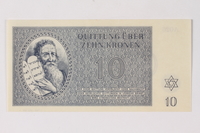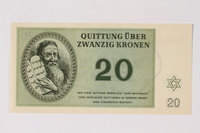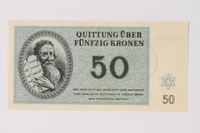Overview
- Brief Narrative
- Scrip, valued at 100 (ein hundert) kronen, of the type issued in Theresienstadt (Terezin) ghetto-labor camp beginning in May 1943. The ghetto currency was printed by the National Bank in 7 similar, beautifully designed denominations: 1, 2, 5, 10, 20, 50, 100. Currency was confiscated from inmates and replaced with scrip for exchange only in the camp. There was little to obtain in exchange for the scrip, except library books. Located thirty miles northwest of Prague in German occupied Czechoslovakia, the ghetto-labor camp was established by the Germans in November 24, 1941, and ceased operation in early May 1945. In 3.5 years, approximately 140,000 Jewish persons were transferred to Terezin; nearly 90,000 were then deported, likely to their death, further east. About 33,000 died in Theresienstadt.
- Date
-
issue:
1943 January 01
- Geography
-
issue:
Theresienstadt (Concentration camp);
Terezin (Ustecky kraj, Czech Republic)
- Credit Line
- United States Holocaust Memorial Museum Collection, Gift of Lawrence Henry and Stella Levy Kirsch
- Markings
- face, upper center, brown ink : QUITTUNG ÜBER / HUNDERT KRONEN [RECEIPT OF / HUNDRED CROWNS]
face, lower center, brown ink : 100
face, lower center, smaller text than above, brown ink : WER DIESE QUITTUNG VERFÄLSCHT ODER NACHMACHT / ODER GEFÄLSCHTE QUITTUNGEN IN VERKEHR BRINGT. / WIRD STRENGSTENS BESTRAFT [ANYONE WHO FALSIFIES OR DISTORTS OR FAKES THIS RECEIPT, OR COUNTERFEITS RECEIPT, WILL BE STRICTLY PUNISHED]
reverse, upper left in border, serial number, red ink : 002226
reverse, lower right, series number, red ink : C
reverse, lower left and upper right corner, brown ink : 100
reverse, center, brown ink : Quittung / über / HUNDERT KRONEN / THERESIENSTADT, AM 1.JANNER 1943 DER ALTESTE DER JUDEN / IN THERESIENSTADT / Jakob Edelstein [Receipt / of / ONE HUNDRED CROWNS / THERESIENSTADT, ON 1. JANUARY 1943 THE ELDER OF THE JEWS IN THERESIENSTADT Jakob Edelstein] - Contributor
-
Printer:
National Bank of Prague
Designer: Peter Kien
Issuer: Der Alteste der Juden in Theresienstadt
- Biography
-
Franz Peter Kien was born January 1, 1919, in Varnsdorf, Czechoslovakia (Czech Republic), to Leonard and Olga Frankl Kien. His father Leonard was born in 1886, in Varnsdorf, and was a member of the German-speaking Jewish population in the, the Sudetenalnd, which bordered Germany. Leonard was a textile manufacturer with his own factory. Peter’s mother Olga was born in 1898, in Bzenec, Austro-Hungary (Czech Republic), to Jewish parents. After 1929, the Kien family moved to Brno. Peter enrolled at the German Gymnasium, where he excelled at drawing, painting, and writing. In 1936, he graduated and moved to Prague to study at the Academy of Fine Arts. He also attended the Officina Pragensis, a private graphic design school run by a well-known Jewish artist, Hugo Steiner-Prag.
On September 29, 1938, Germany annexed the Sudetenland. On March 15, 1939, Germany invaded Prague and annexed the Bohemia and Moravia provinces of Czechoslovakia, ruled by a Reich Protector. Jews were banned from participation in government, businesses, and organization, including schools. Peter had to leave the Academy, but continued to study at the Officina Pragensis. He also taught at Vinohrady Synagogue. In September 1940, Peter married Ilse Stranska, who was born on May 9, 1915, in Pilsen, to Jewish parents.
In late September 1941, Reinhard Heydrich, the SS head of RSHA, Reich Main Security Office, became Reich Protector. Soon there were regular deportations of Jews to concentration camps. At the end of November, Theresienstadt concentration and transit camp near Prague got its first shipment of Jewish prisoners. On December 14, Peter was transported to Theresienstadt ghetto-labor camp. He was assigned to the technical department where he worked as a draftsman and designer alongside other artists, including Bedrich Fritta, Leo Haas, and Jiri Lauscher. On July 16, 1942, Peter’s wife Ilse arrived in the camp. On January 30, 1943, Peter’s parents Leonard and Olga were transported from Bzenec to Terezin. Peter was assigned major projects by the Jewish Council that administered the camp for the Germans, such as the scrip receipts used in place of money in the camp. He secretly documented the inmate’s daily life, creating portraits and other drawings, and wrote plays, poems, and an operatic libretto. On October 16, 1944, Peter’s wife Ilse and his parents Leonard and Olga were selected for deportation. Peter volunteered to go with them. Before leaving, Peter and his family were sent to Auschwitz concentration camp in German-occupied Poland. Peter survived the selection process, soon fell ill, likely with typhus, and died at age 25 in late October 1944. His wife and parents were killed at Auschwitz. Some of the work that Peter left with other prisoners or hid at Theresienstadt survived and has been exhibited worldwide.
Physical Details
- Language
- German
- Classification
-
Exchange Media
- Category
-
Money
- Object Type
-
Scrip (aat)
- Physical Description
- Theresienstadt scrip printed on rectangular, watermarked, offwhite paper in black, orange, and red-brown ink. The face has a vignette of Moses, a bearded man with a wrinkled brow, holding 2 stone tablets with the 10 Commandments in Hebrew. To the right is the denomination 100 and German text. The background rectangle has an abstract, repeating pattern. On the right is a wide offwhite border with 100 in the bottom corner below a Star of David. The reverse has a background rectangle with a zigzig pattern with an underprint flourish, overprinted with German text, an engraved signature, and a scrollwork line. The denomination 100 is in the upper right corner. On the left is a wide offwhite border with 100 in the bottom corner below a Star of David in a lined circle. The serial number in red ink is in the upper left corner. The series letter in red ink is in the lower right. Scrip appears unused.
- Dimensions
- overall: Height: 3.000 inches (7.62 cm) | Width: 5.875 inches (14.923 cm)
- Materials
- overall : paper, ink
Rights & Restrictions
- Conditions on Access
- No restrictions on access
- Conditions on Use
- No restrictions on use
Keywords & Subjects
Administrative Notes
- Legal Status
- Permanent Collection
- Provenance
- The scrip was donated to the United States Holocaust Memorial Museum in 1989 by Lawrence and Stelly Levy Kirsch.
- Funding Note
- The cataloging of this artifact has been supported by a grant from the Conference on Jewish Material Claims Against Germany.
- Record last modified:
- 2024-07-09 12:46:03
- This page:
- https://collections.ushmm.org/search/catalog/irn521795
Download & Licensing
In-Person Research
- By Appointment
- Request 21 Days in Advance of Visit
- Plan a Research Visit
- Request to See This Object
Contact Us
Also in Lawrence and Stelly Levy Kirsch collection
The collection consists of seven pieces of scrip of the type issued in the Theresienstadt ghetto-labor camp in German occupied Czecoslovakia during the Holocaust.
Date: after 1943 May-approximately 1944

Theresienstadt ghetto-labor camp scrip, 1 krone note
Object
Scrip, valued at 1 (eine) krone, of the type distributed in Theresienstadt (Terezin) ghetto-labor camp beginning in May 1943. The ghetto currency was printed by the National Bank in 7 denominations: 1, 2, 5, 10, 20, 50, 100. Currency was confiscated from inmates and replaced with scrip for exchange only in the camp. There was little to obtain in exchange for the scrip, except library books. Located thirty miles northwest of Prague in German occupied Czechoslovakia, the ghetto-labor camp was established by the Germans in November 24, 1941, and ceased operation in early May 1945. In 3.5 years, approximately 140,000 Jewish persons were transferred to Terezin; nearly 90,000 were then deported, likely to their death, further east. About 33,000 inmates died in Theresienstadt.

Theresienstadt ghetto-labor camp scrip, 2 kronen note
Object
Scrip, valued at 2 (zwei) kronen, of the type distributed in Theresienstadt (Terezin) ghetto-labor camp beginning in May 1943. The ghetto currency was printed by the National Bank in 7 similar, beautifully designed denominations: 1, 2, 5, 10, 20, 50, 100. Currency was confiscated from inmates and replaced with scrip for exchange only in the camp. There was little to obtain in exchange for the scrip, except library books. Located thirty miles northwest of Prague in German occupied Czechoslovakia, the ghetto-labor camp was established by the Germans in November 24, 1941, and ceased operation in early May 1945. In 3.5 years, approximately 140,000 Jewish persons were transferred to Terezin; nearly 90,000 were then deported, likely to their death, further east. About 33,000 died in Theresienstadt.

Theresienstadt ghetto-labor camp scrip, 5 kronen note
Object
Scrip, valued at 5 (funf) kronen, of the type distributed in Theresienstadt (Terezin) ghetto-labor camp beginning in May 1943. The ghetto currency was printed by the National Bank in 7 similar, beautifully designed denominations: 1, 2, 5, 10, 20, 50, 100. Currency was confiscated from inmates and replaced with scrip for exchange only in the camp. There was little to obtain in exchange for the scrip, except library books. Located thirty miles northwest of Prague in German occupied Czechoslovakia, the ghetto-labor camp was established by the Germans in November 24, 1941, and ceased operation in early May 1945. In 3.5 years, approximately 140,000 Jewish persons were transferred to Terezin; nearly 90,000 were then deported, likely to their death, further east. About 33,000 died in Theresienstadt.

Theresienstadt ghetto-labor camp scrip, 10 kronen note
Object
Scrip, valued at 10 (zehn) kronen, of the type distributed in Theresienstadt (Terezin) ghetto-labor camp beginning in May 1943. The ghetto currency was printed by the National Bank in 7 similar, beautifully designed denominations: 1, 2, 5, 10, 20, 50, 100. Currency was confiscated from inmates and replaced with scrip for exchange only in the camp. There was little to obtain in exchange for the scrip, except library books. Located thirty miles northwest of Prague in German occupied Czechoslovakia, the ghetto-labor camp was established by the Germans in November 24, 1941, and ceased operation in early May 1945. In 3.5 years, approximately 140,000 Jewish persons were transferred to Terezin; nearly 90,000 were then deported, likely to their death, further east. About 33,000 died in Theresienstadt.

Theresienstadt ghetto-labor camp scrip, 20 kronen note
Object
Scrip, valued at 20 (zwanzig) kronen, distributed in Theresienstadt (Terezin) ghetto-labor camp beginning in May 1943. The ghetto currency was printed by the National Bank in 7 similar, beautifully designed denominations: 1, 2, 5, 10, 20, 50, 100. Currency was confiscated from inmates and replaced with scrip for exchange only in the camp. There was little to obtain in exchange for the scrip, except library books. Located thirty miles northwest of Prague in German occupied Czechoslovakia, the ghetto-labor camp was established by the Germans in November 24, 1941, and ceased operation in early May 1945. In 3.5 years, approximately 140,000 Jewish persons were transferred to Terezin; nearly 90,000 were then deported, likely to their death, further east. About 33,000 died in Theresienstadt.

Theresienstadt ghetto-labor camp scrip, 50 kronen note
Object
Scrip, valued at 50 (funfzig) kronen, of the type distributed in Theresienstadt (Terezin) ghetto-labor camp beginning in May 1943. The ghetto currency was printed by the National Bank in 7 similar, beautifully designed denominations: 1, 2, 5, 10, 20, 50, 100. Currency was confiscated from inmates and replaced with scrip for exchange only in the camp. There was little to obtain in exchange for the scrip, except library books. Located thirty miles northwest of Prague in German occupied Czechoslovakia, the ghetto-labor camp was established by the Germans in November 24, 1941, and ceased operation in early May 1945. In 3.5 years, approximately 140,000 Jewish persons were transferred to Terezin; nearly 90,000 were then deported, likely to their death, further east. About 33,000 died in Theresienstadt.



